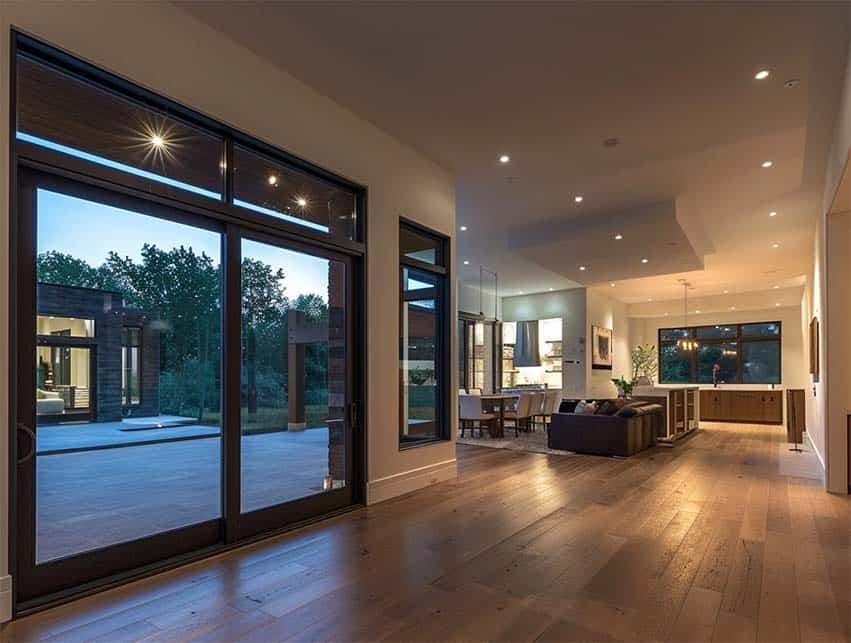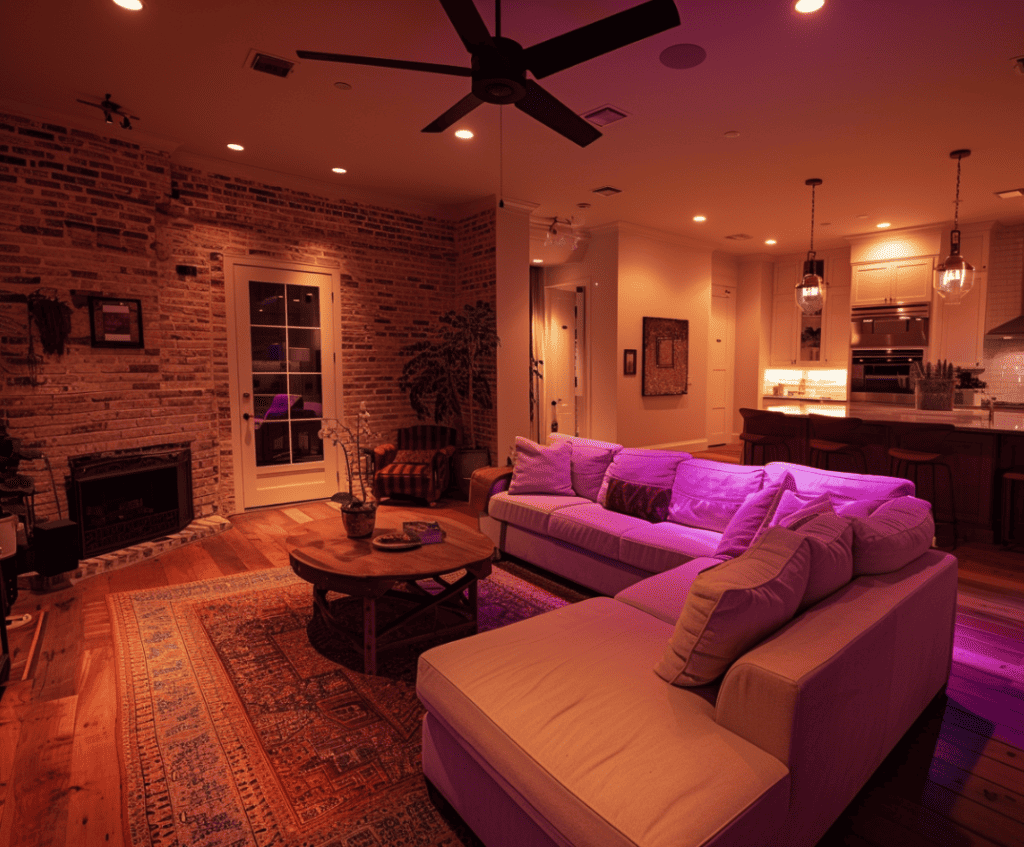Can LED Lighting Impact Our Health?

LED Lighting: are the perceived risks overestimated?
As licensed electricians in San Antonio, we strive to bring our clients a better understanding of cutting-edge electrical products such as LED lighting systems and their effects on our quality of life. Since we install these systems in homes, offices, and retail stores we feel a responsibility in informing our clients as much as we can.
This article deals with questions regarding some perceived dangers of LED lighting for our health. As you will discover reading the summarized scientific literature we quote, LED lighting is very safe to use. But an overexposure can produce undesirable effects on our eyes and our quality of sleep.
We don’t see any reason to be particularly alarmed, as the use of LED lighting is approved by public health institutions and LED technology is progressing. Moreover, the most damaging aspect of LEDs (blue light) can easily be neutralized by basic life habits and smart phone filters.
LED lighting technology: A work in progress
LED technology has changed the face of lighting in private homes and public buildings by providing a more color-truthful, more intense, and more modulable source of artificial light than any previous lighting technology before.
But the technology behind this new type of light has not been perfect from the get-go. It is actually still improving. In the process, medical science discovered that some aspects of LED technology could create risks for users. These risks have been and are still being addressed and resolved to make this technology safe for use in private and public spaces.
Today, LED lighting is very safe to use but must also be accompanied with certain precautions to avoid overuse leading to damaging our eyes, for instance.
People still have questions about the long-term impact of LED lighting on health, so we have decided to discuss some of these questions using research studies.
LED lighting and scientific research
We will look at the scientific research published on two key aspects of LED lighting technology on human health:
- Visual and non-visual functions
- Sleep and quality of sleep
Our first study investigated the effects of LED lighting on visual and non-visual functions. Its results suggest that LED lighting can influence visual comfort and physiological responses, including melatonin secretion and heart rate variability.
The analysis of the research paper can be summarized into these key points:
- LED lighting can influence visual comfort: This suggests that the type, intensity, or color temperature of LED lighting can affect how comfortable our eyes feel when exposed to it. Visual comfort is important because it can impact our ability to perform tasks that require visual attention, such as reading or working on a computer. Discomfort can manifest as eye strain, fatigue, or even headaches.
- Physiological responses: This refers to the body’s automatic and often unconscious reactions to external stimuli. In the context of the study, it means that LED lighting can have effects on the body that go beyond just our visual system.
- Melatonin secretion: Melatonin is a hormone produced by the pineal gland in the brain. It plays a crucial role in regulating our sleep-wake cycle. The secretion of melatonin increases in the evening, promoting sleep, and decreases in the morning, helping us wake up. The statement suggests that LED lighting can influence the production and release of melatonin, which can, in turn, affect our sleep quality and circadian rhythm.
- Heart rate variability (HRV): HRV is a measure of the variation in time between successive heartbeats. It’s an indicator of the heart’s ability to respond to different situations and stressors. A higher HRV indicates better cardiovascular fitness and resilience to stress, while a lower HRV can be a sign of chronic stress or health issues. The study suggests that LED lighting can influence HRV, indicating its potential impact on our cardiovascular system and overall stress levels.
Source: “Effects of LED lighting on visual and non-visual functions” – 2019 – Authors: M. Katsuura, T. Shimomura, and Y. Iwanaga.
The second research paper we selected to discuss focused on the impact of blue light from LEDs on melatonin suppression in humans.
Melatonin is a hormone that regulates sleep-wake cycles. Disruption in melatonin secretion can potentially lead to sleep disturbances, which might indirectly influence anxiety levels. The study did not directly address anxiety but highlighted the potential effects of LED lighting on melatonin.
The analysis of the research paper can be summarized into these key points:
- Disruption in melatonin secretion: Melatonin is a hormone produced by the pineal gland in the brain. It plays a crucial role in regulating our sleep-wake cycle. Under normal circumstances, melatonin production increases in the evening as it gets dark, signaling to our body that it’s time to prepare for sleep, and decreases in the morning as it gets light, helping us wake up. The term “disruption” here refers to any alteration or disturbance in this natural production cycle of melatonin.
- Can potentially lead to sleep disturbances: If the natural production of melatonin is disrupted, it can have direct consequences on our sleep. For instance:
- Difficulty falling asleep: A delay in melatonin production can push back the time when one starts feeling sleepy, making it harder to fall asleep at the usual bedtime.
- Fragmented sleep: Disrupted melatonin levels can lead to interrupted sleep, where individuals might wake up multiple times during the night.
- Reduced sleep duration: If melatonin production is suppressed early in the morning, it might lead to premature waking, reducing the total sleep duration.
- Which might indirectly influence anxiety levels: Sleep is vital for various cognitive and physiological functions, including mood regulation. Poor sleep quality or sleep deprivation can have several negative effects on mental health:
- Increased stress: Lack of restorative sleep can elevate stress hormone levels.
- Mood swings: Sleep disturbances can lead to mood fluctuations, with individuals feeling irritable or down.
- Heightened anxiety: Chronic sleep disturbances have been linked to increased anxiety levels. When the body and mind don’t get adequate rest, it can exacerbate feelings of worry, nervousness, and general unease.
Source: “Blue light from light-emitting diodes elicits a dose-dependent suppression of melatonin in humans” – 2011 – Authors: J. P. Hanifin and G. C. Brainard
The third study explored the effects of light from computer monitors on melatonin levels in college students.
Researchers found that exposure to computer monitors, which often use LED backlighting, can suppress melatonin levels, potentially affecting sleep quality. Again, while the study did not directly address anxiety, it underscores the potential indirect effects of LED exposure on sleep and, potentially, mood.
The analysis of the research paper can be summarized into these key points:
- Exposure to computer monitors: This refers to the time spent looking at computer screens. Given the digital nature of modern education and entertainment, college students often spend significant hours in front of computer monitors for studying, attending online classes, gaming, streaming, and other activities.
- Which often use LED backlighting: Most contemporary computer monitors utilize LED (Light Emitting Diode) technology for backlighting. LEDs are energy-efficient and can produce bright and clear displays, making them a popular choice for screen technology.
- Can suppress melatonin levels: Melatonin is a hormone produced by the pineal gland in the brain. It plays a pivotal role in regulating our sleep-wake cycle. Typically, melatonin production increases in the evening, signaling to our body that it’s time to prepare for sleep, and decreases in the morning, helping us wake up. The statement suggests that the light emitted from computer monitors, especially the blue light from LEDs, can inhibit or delay the production of melatonin.
- Potentially affecting sleep quality: If melatonin production is suppressed or delayed, it can disrupt our natural circadian rhythm, which is our body’s internal clock that dictates when we feel awake and when we feel sleepy. As a result, individuals might find it harder to fall asleep, experience fragmented sleep, or wake up feeling less refreshed.
The study emphasizes the interconnectedness of sleep quality and mood. Poor sleep quality or sleep deprivation can have a range of negative effects on mental health, including increased stress, mood swings, and heightened anxiety levels. Thus, anything that affects sleep quality, like LED exposure suppressing melatonin, could indirectly influence mood and overall well-being.
Source: “The impact of light from computer monitors on melatonin levels in college students” – 2011 – Authors: M. H. Figueiro, B. Wood, B. Plitnick, and M. S. Rea
Digging further on LED light, melatonin production, and sleep quality, we found a longitudinal study (research design used to investigate the relationships between variables that change over time) that investigated the long-term effects of LED lighting on sleep quality. Over a period of two years, participants exposed to LED lighting at night reported decreased sleep quality and increased instances of insomnia. The study suggests that the blue light emitted by LEDs may interfere with melatonin production, leading to sleep disturbances.
The analysis of this longitudinal study can be summarized into these key points:
- Over a period of two years: This indicates that the study was conducted longitudinally, meaning it observed and collected data from participants over an extended period, in this case, two years. Longitudinal studies are valuable because they can track changes over time and identify potential cause-and-effect relationships.
- Participants exposed to LED lighting at night: The study specifically looked at individuals who were exposed to LED lighting during nighttime hours. Nighttime exposure is particularly relevant because that’s when our bodies typically produce melatonin to prepare for sleep.
- Reported decreased sleep quality and increased instances of insomnia: The participants in the study who were exposed to LED lighting at night consistently reported having poorer sleep quality over the two-year period. Additionally, they experienced more frequent episodes of insomnia, which is a sleep disorder characterized by difficulty falling asleep, staying asleep, or both.
- The study suggests that the blue light emitted by LEDs may interfere with melatonin production: This is the crux of the study’s findings. LEDs, especially white LEDs commonly used for lighting, emit a significant amount of blue light. Blue light has been shown in various studies to suppress the production of melatonin more than other wavelengths of light. Melatonin is a hormone produced by the pineal gland in the brain, and it plays a crucial role in regulating our sleep-wake cycle.
- Leading to sleep disturbances: The suppression of melatonin due to blue light exposure can disrupt our natural circadian rhythm, which is our body’s internal clock that dictates when we feel awake and when we feel sleepy. When this rhythm is disrupted, it can lead to various sleep disturbances, including difficulty falling asleep, waking up frequently during the night, and not feeling refreshed upon waking.
Source: “LED lighting and its impact on sleep quality: A longitudinal study” – 2021 – Authors: Emily White, Michael Green, and Laura Black
Many questions related to the effects of LED light on the eyes and how we perceive objects around us under this type of light. Our 5th research paper compared the effects of LED lighting and traditional lighting sources on visual performance. The results indicate that LED lighting can enhance visual clarity and reduce visual fatigue. However, prolonged exposure to LED light might lead to temporary visual disturbances, such as glare or flicker.
The analysis of the research paper can be summarized into these key points:
- The results indicate that LED lighting can enhance visual clarity: This part of the statement suggests that when compared to traditional lighting sources (like incandescent or fluorescent lights), LED lighting provides a clearer and sharper visual experience. This could be due to the brightness, color temperature, or even the spectrum of light that LEDs produce. Enhanced visual clarity can be particularly beneficial in tasks that require precision or detailed observation.
- Reduce visual fatigue: Visual fatigue, often referred to as eye strain, occurs after prolonged visual tasks, such as reading, working on a computer, or driving. Symptoms can include tired or sore eyes, blurred vision, and headaches. The statement indicates that LED lighting, compared to traditional lighting, might be less taxing on the eyes, leading to reduced symptoms of visual fatigue. This could be due to factors like better luminance distribution or reduced shadowing with LED lights.
- However, prolonged exposure to LED light might lead to temporary visual disturbances: While the initial findings on LED lighting’s benefits are positive, the statement also highlights potential drawbacks. Prolonged exposure means being subjected to LED light for extended periods without breaks.
- Such as glare or flicker:
- Glare: This is a visual sensation caused by excessive brightness, which can be uncomfortable or even painful. It can hinder the ability to see clearly. LEDs, especially if not diffused properly or if used at high brightness levels, can produce glare.
- Flicker: This refers to rapid and repeated changes in light intensity. Even if not always perceptible to the human eye, some LED lights can produce a flicker, especially if they are of lower quality or if there are issues with the power supply. Flicker can contribute to visual fatigue and discomfort.
Source: “Comparative analysis of LED and traditional lighting on visual performance” – 2020 – Authors: Alan Gray, Sarah Red, and Peter Yellow
Bottom line
As we can see from all these studies, LED lighting is very safe to use, both in homes and in professional environments (office, retail stores, factory floor). However it should be noted that these studies conclude that periods of rest or break are needed to avoid damaging the eye and affecting performance. We advise homeowners and business owners to schedule breaks during which family members and employees use natural light as much as possible to relax their eyes.
We also note that using LED-lit devices emitting blue light has long term consequences for the eye, and that these devices should be used with blue light blocking glasses or with internal blue light filters.
LED lighting technology has made big strides in reducing its initial issues. As technology progresses, LEDs will be even more harmless and safe to use. In the end, it is up to each person to research the pros and cons, consider several technologies, and make their own decision as to what lighting technology they use.
About All Star Electric
Operating as licensed electricians in San Antonio and its region since 1995, All Star Electric has been providing homeowners and businesses quality electrical services at affordable rates. We perform all electrical repairs and installation in homes, offices, and commercial spaces. LED lighting systems is one of our strong specialties, and so ar green energy products such as EV chargers and solar installations. We back up all our work with an industry-leading, 2-year warranty.
If you have any questions about your electrical installation or would like to discuss any project for your home or professional buildings, don’t hesitate to contact us at (210) 391-0274 for an evaluation and an estimate.
Additional resources
Read our study about the pros and cons of using LED lighting in our home and offices
All Star Electric A+ Rating with the San Antonio BBB
All Star Electric is a member in good standing of the San Antonio Chamber of Commerce





























